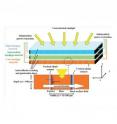Ben-Gurion University develops side-illuminated ultra-efficient solar cell designs
Researchers at Ben-Gurion University of the Negev (BGU) have developed a radically new design for a concentrator solar cell that, when irradiated from the side, generates solar conversion efficiencies that rival, and may eventually surpass, the most ultra-efficient photovoltaics. The new cell architecture developed at the David Ben-Gurion National Solar Research Center at BGU can exceed an ultra-efficient 40 percent conversion efficiency with intensities equal to 10,000 suns.
"Typically a concentrator solar cell comprises interdependent stacked materials connected in series, with significant associated fabrication difficulties and efficiency limitations," explains Prof. Jeffrey Gordon, a member of the Department of Solar Energy and Environmental Physics at BGU's Jacob Blaustein Institutes for Desert Research.
"Our new designs for concentrator photovoltaic cells comprise multiple tiers of semiconductor materials that are totally independent, and overcome numerous challenges in compiling the elements of even the most efficient solar cells," he says.
The BGU invention also demonstrates the distinctly new possibility of exploiting common materials, such as silicon, previously deemed unsuitable under highly concentrated solar radiation. Tailoring the cells to edge (side) illumination reduces the cell internal resistance to negligible levels.
This increases the solar concentration levels at which cell efficiency peaks to up to 10,000 times ambient solar beam radiation, which is significantly higher than ever before.
"Our future depends on the development of alternative energies, and BGU is leading the way in this field," explains Doron Krakow, executive vice president of American Associates, Ben-Gurion University of the Negev (AABGU). "Prof. Gordon and his colleagues in BGU's Energy Initiative continue to bring new innovations that will impact our world for the better."
The new technology was recently detailed in a paper that appeared in Energy & Environmental Science.
Source: American Associates, Ben-Gurion University of the Negev
Other sources
- Side-illuminated ultra-efficient solar cell designs developedfrom Science DailyThu, 8 Nov 2012, 22:30:31 UTC
- Researchers develops side-illuminated ultra-efficient solar cell designsfrom Science BlogThu, 8 Nov 2012, 15:30:36 UTC
- Team develops side-illuminated ultra-efficient solar cell designsfrom PhysorgThu, 8 Nov 2012, 8:30:41 UTC
